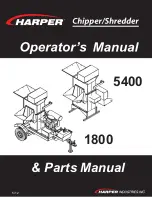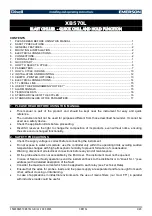
To ensure that galvanized steel surfaces are passivated, for the first 6-8 weeks of operation, the pH of the tank
water should be maintained between 7.0 and 8.2 and calcium hardness maintained between 100 and 300 mg/l (as
CaCO
3
). The passivation is complete and effective when the new zinc surfaces turn dull grey in colour. If white
deposits form on galvanized steel surfaces after the pH is returned to normal, this is a sign of white rust, and
therefore, the passivation process should be repeated to insure proper passivation and maximum corrosion
resistance.
In case that your water quality does not allow the pH to remain below 8.2, then you should consult a water
treatment specialist for advice on pH reduction or special passivation agents to promote proper passivation.
Special water treatment considerations
ICE TANK WATER
•
Since ice tanks can be on and off during the course of the year, it is possible for microbiological growth to
develop. Therefore, the best practice hygiene recommendation is for a dosage of non-oxidizing biocide
once/year. If the unit is an external melt, the biocide should be added after the unit is brought down for cleaning
and during the refill process, to insure proper mixing.
•
Following passivation, if the tank water is corrosive in nature (low hardness, low pH or alkalinity), the addition
of a corrosion 'non-precipitating' corrosion inhibitor is recommended. Examples of 'non-precipitating' corrosion
inhibitors are nitrites, molybdates and silicate based blends. Care must be taken not to use corrosion inhibitors
that raise the conductivity > 700 µS/cm, or alter the freezing point of the water. Therefore, such decisions need
to be taken with the advice of a water treatment specialist. For example, if the ice water needs food grade
approval because it could contaminant food products, then the silica based treatment programme is normally
used, if it meets food grade regulations.
GLYCOL SIDE OF THE ICE COIL
•
Only use "inhibited" glycol that contains pH buffers. Never use industrial grade ethylene glycol. The reason for
this recommendation is that over time, glycol degrades and produces "glycolic acid" as a result. These acids
reduce the pH of the circulating water, and this will cause corrosion of steel materials of construction.
•
As an added protection, the glycol loop should be treated with a nitrite, molybdate or silicate-based corrosion
inhibitor to promote metal passivation, and provide additional alkalinity to raise the pH above 9.0. Always
consult a water treatment specialist for recommendations on which corrosion inhibitor is most effective for your
specific water quality
W W W . B A L T I M O R E A I R C O I L . E U
16
Summary of Contents for ICE CHILLER TSC-C-D
Page 24: ...W W W B A L T I M O R E A I R C O I L E U 24...
Page 25: ...W W W B A L T I M O R E A I R C O I L E U...
Page 26: ...W W W B A L T I M O R E A I R C O I L E U...
Page 27: ...W W W B A L T I M O R E A I R C O I L E U...
Page 28: ...W W W B A L T I M O R E A I R C O I L E U...















































